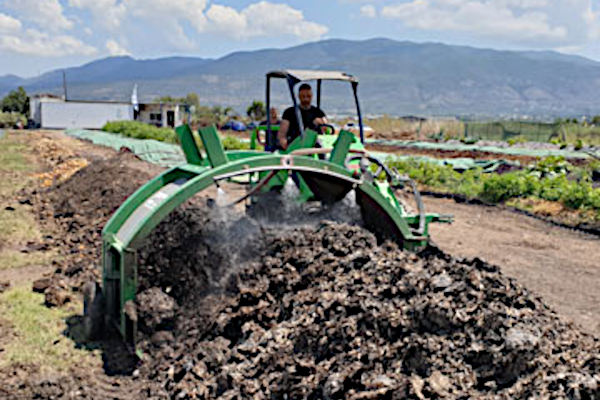
On the 9-10 June 2021 the Institute of Ecological Agriculture DIO participated in the two-day Seminar about Biocyclic Composting which was organized by the BIOCYCLIC PARK PC in collaboration with BNS BIOCYCLIC NETWORK SERVISES.
The training took place at the facilities of the Biocyclic Park in Kalamata. The basic principles of composting were explained both in technical and practical level and the technical equipment of a composting unit. Particularly interesting was the production process of Biocyclic Humus Soil and its final characteristics. Mr. Johannes Eisenbach, coordinator of the Panhellenic Network of Biocyclic Agriculture and Lydia Eisenbach, the director of Biocyclic Park PC transferred their experience and knowledge on the subject and conveyed to us the importance of waste management of olive mills in the area and their conversion into compost.
COMPOST PRODUCTION IN THE BIOCYCLIC PARK
The unit processes plant-based raw materials (olive kernels and marcs, olive leaves, vegetables and fruits from nearby farms, pruning, mushroom substrate and herbs) and does not use manure as a raw material. Sometimes soil or ready-made compost is added to the hills. The composting is of agricultural type and follows the process of thermophilic aerobic fermentation on hills. Compost is a ‘living organism’, the aim is to create the best conditions for the microorganisms that already exist to act. Crucial to a good quality final product and suitable for use in organic farming is the proper treatment of the compost hill and the appropriate interventions based on the composting stage such as stirring and irrigation. Stirring is very common at the beginning of the process, but gradually decreases. Regular analyzes are made of the percentage of carbon dioxide inside the compost hill, the temperature and the percentage of humidity to determine the quality parameters. The hills are protected by a specialist fabric (compost fleece) from adverse environmental conditions. In 6-8 weeks from the beginning of the composting process on the hills, regardless of the season, the compost is ready for use as a soil conditioner.
In the unit, the fresh and high quality compost is the necessary for the production of the humus soil. Those hills that are not removed for immediate sale remain in their places for further maturation. After a period of ripening (about a year) begins the plantation of the humus soil with different seedlings without the use of fertilizers. With continuous planting and the time-frame of at least 3-4 years, the compost is transformed into a material that looks like soil, and was named by Mr. Eisenbach “Humus soil”. The humic components are stabilized to a large extent in contrast to the fresh compost.


